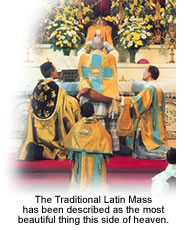|
|
 Tradition
is an essential part of the Christian religion. Tradition and Scripture,
as the two sources of divine revelation, are the foundations of our Faith.
In a broader sense, tradition works. Let's illustrate this point with
an example from the history of exploration. Through experience, the well-known
Danish explorer Peter Freuchen found that the local traditional means
of travel were generally the safest and most effective. "He was sure
no clever modern inventor could sit in his laboratory and think out anything
better than what the experience of thousands of years had taught the Eskimos
to use in their own region."1 Tradition
is an essential part of the Christian religion. Tradition and Scripture,
as the two sources of divine revelation, are the foundations of our Faith.
In a broader sense, tradition works. Let's illustrate this point with
an example from the history of exploration. Through experience, the well-known
Danish explorer Peter Freuchen found that the local traditional means
of travel were generally the safest and most effective. "He was sure
no clever modern inventor could sit in his laboratory and think out anything
better than what the experience of thousands of years had taught the Eskimos
to use in their own region."1
Tradition grows organically through a continual sifting of ideas and experiences.
Learning acquired through the process of tradition accumulates through
the painstaking process of trial and error. As a result, tradition works
because it is the accumulation of the wisdom of the ages. In contrast,
modernity represents the wisdom of just one generation. It is for this
reason that the fruits of tradition are superior to those of modernity.
"By their fruits you shall know them" (Matthew 7:20). It is
now obvious that that the Church is in the throes of an unprecedented
crisis. Today, the Church faces the mortal danger of the modernist heresy,
described by St. Pius X as the synthesis of all heresies. Prior to the
Second Vatican Council, the Church was a flourishing and respected, if
not always liked, institution. Numerically, the Church was growing ever
stronger, coping successfully with challenges such as the secularizing
influences of industrial society and opposition from atheistic communism.
Since the Second Vatican Council and the subsequent modernization of Church
life, Catholicism has suffered from declining church attendance and seminary
enrolment, to cite just two examples of today's unprecedented collapse
in religious observance. Within the Church, modernity has proven itself
to be a bankrupt ideology.
In other walks of life, modernity has proven itself to be just as bankrupt.
We have abandoned traditional family life and ended up with countless
children suffering from the agonizing effects of family breakdown. We
have abandoned traditional morality and ended up with epidemics of disease.
In education, we have abandoned traditional methods of instruction and
discipline and ended up with children who can't read and a situation where
bullying in schools is out of control. In economics, we have abandoned
the idea that prosperity may have something to do with hard work, saving,
and thrift rather than borrowing and spending and ended up with a tidal
wave of bankruptcies.
The brutal nature of communism is a subject that has received much attention.
A less discussed characteristic of communism is its drabness. Citizens
of communist countries spend endless hours waiting in line for shoddy
goods. They live and work in dreary buildings, the product of Stalinist
architecture. Similarly, a not-so-discussed characteristic of modernity
is its drabness. Modern art is unappreciated by and unintelligible to
the great majority of individuals. It is an understatement to say that
the beauty of the skyscrapers which dominate the skylines of modern cities
pale in comparison to the castles and cathedrals of the medieval period.
Life in modern society often consists of being tied up in traffic jams
enroute to and from boring jobs, after which evenings are spent eating
plastic food in front of dumbed-down television programs designed to appeal
to the lowest common denominator. Modern society is organized dysfunctionally,
with cities so crowded that much time is wasted in traffic jams, houses
are unaffordable to many families, and social problems such as high crime
rates abound. Meanwhile, much of the countryside has become so depopulated
that many rural communities find it difficult to maintain basic services
or a viable community social life.
Modern Church life is also characterized by drabness. Modern church buildings,
if not ugly monstrosities, are certainly almost always devoid of any spiritual
inspiration. The new liturgy is full of boring banalities. The rich Catholic
treasure house of devotions, pilgrimages, sacred art, the wise writings
of the Church fathers, and so on, lies mostly forgotten.
There is an answer to the failures and drabness of modern times. There
is an answer to the present crisis of the Church. The answer is not to
implement the phoney solutions being proposed by liberals. More of the
same liberalism that caused the problem in the first place will not solve
the problem. The answer is to return to the tried, tested, and true principles
of tradition. In his book, The Antichrist, Fr. Vincent Miceli explained
that every crisis in the Church's history has consisted of a confrontation
between tradition and novelty. In every case, tradition has eventually
triumphed.
Tradition adds meaning to our lives, giving us a sense of who we are.
If certain aspects of life, such as the way we worship, are continually
changing, confusion abounds. Malachi Martin once illustrated this truth
by pointing out that if the American flag were continually changing, people
would soon lose a sense of what it means to be American. Incidentally,
Canada's flag was changed, a factor that may have contributed to this
country's weak and confused sense of identity. Since Vatican II, virtually
all aspects of Church life have been turned upside down, so it is not
surprising that so many souls have lost a sense of what it means to be
Catholic.
Tradition endures, whereas modernity does not. It is an old saying that
if you marry one generation, you will end up as a widow in the next. Tradition
maintains its value and appeal as ages pass. The great Gothic cathedrals
are just as impressive today as when they were built hundreds of years
ago. In contrast, the styles of the 1960's have dated rapidly and already
look ridiculous.
Writing from the perspective of someone living in the New World, Triumph
Communications is committed to recovering the ethnic heritage of our European
ancestors. Imbedded, often imperceptibly, in the cultures of European
nations are centuries of Christian traditions. As Hillaire Belloc wrote,
"The Faith is Europe. And Europe is the Faith."2
There is one final aspect of tradition that is of prime importance. In
raising a family, it is an error to neglect the fun component of the Faith.
Without this component, the children of even devout parents will likely
eventually lapse from the Faith. Traditional Catholicism recognized this
principle, weaving a colourful tapestry of feasts to celebrate throughout
all seasons of the year.
In conclusion, Triumph Communications invites you to join with us in a
crusade to recover and restore the traditions that made us strong, that
made this life a joy as well as a sacrifice, and that led our souls to
their eternal destiny. It is in recovering our traditions that we can
lay the foundation for the restoration of a Christian civilization.
1 Heyrdahl, The Kon-Tiki
Expedition, pp. 29-30.
2 Belloc, Europe and the Faith, p. 192.
|



